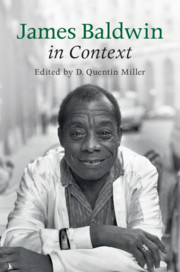Book contents
- James Baldwin in Context
- James Baldwin in Context
- Copyright page
- Contents
- Contributors
- Introduction: James Baldwin in Context
- Part 1 Life and Afterlife
- Part 2 Social and Cultural Contexts
- Part 3 Literary Contexts
- Chapter 19 The Protest Essay Tradition
- Chapter 20 Baldwin and the Black Arts Movement
- Chapter 21 Baldwin and the Rhetoric of Confession
- Chapter 22 The Poetics of Beautiful Blackness On Baldwin and Négritude
- Chapter 23 Mid-Century Theater
- Chapter 24 Sex and the Twentieth-Century Novel
- Chapter 25 Responding to Richard Wright
- Chapter 26 Baldwin’s Literary Friendships
- Chapter 27 Reviewers, Critics, and Cranks
- Chapter 28 Baldwin’s Collaborative Dance
- Chapter 29 Baldwin’s Literary Progeny
- Index
Chapter 24 - Sex and the Twentieth-Century Novel
from Part 3 - Literary Contexts
Published online by Cambridge University Press: 12 July 2019
- James Baldwin in Context
- James Baldwin in Context
- Copyright page
- Contents
- Contributors
- Introduction: James Baldwin in Context
- Part 1 Life and Afterlife
- Part 2 Social and Cultural Contexts
- Part 3 Literary Contexts
- Chapter 19 The Protest Essay Tradition
- Chapter 20 Baldwin and the Black Arts Movement
- Chapter 21 Baldwin and the Rhetoric of Confession
- Chapter 22 The Poetics of Beautiful Blackness On Baldwin and Négritude
- Chapter 23 Mid-Century Theater
- Chapter 24 Sex and the Twentieth-Century Novel
- Chapter 25 Responding to Richard Wright
- Chapter 26 Baldwin’s Literary Friendships
- Chapter 27 Reviewers, Critics, and Cranks
- Chapter 28 Baldwin’s Collaborative Dance
- Chapter 29 Baldwin’s Literary Progeny
- Index
Summary
One of the crucial roles of literature in society is to narrate issues that are regarded as unspeakable and thereby to test and stretch the limits of propriety. The social conventions attached to sex and sexualities emblematize this. Right from the start of his literary career, many of James Baldwin’s writings have encountered and negotiated the ever-shifting frontiers of the publicly accepted and prohibited, especially through his depictions of sexuality, as well as race, gender, and class. He was early in his realization that these and other categories of identity are unavoidably related and intertwined, that is, in other words, intersectional. This becomes evident particularly in his fiction, where different aspects of identity are explicated through Baldwin’s sophisticated and intimate language. As a result, one of the most constant aspects of his work is the unwavering questioning and challenging of the limits of conventional propriety. Compared to many earlier African American writers, portrayals of sex and sexuality hold a significantly more central place at the very heart of Baldwin’s writing. As Baldwin himself argued concerning earlier African American literature, “there is a great space where sex ought to be; and what usually fills this space is violence.” In Baldwin’s work, sex, in the context of mutual affection and respect, becomes an act of confession, a moment of transcendence that offers a glimpse of a postcategorical world where the oppressive power of identity categories would lose its hold. Importantly, Baldwin was also at the forefront in his portrayals of non-normative same-sex desire between men, which has made him an iconic figure for black queer studies.
- Type
- Chapter
- Information
- James Baldwin in Context , pp. 254 - 263Publisher: Cambridge University PressPrint publication year: 2019



